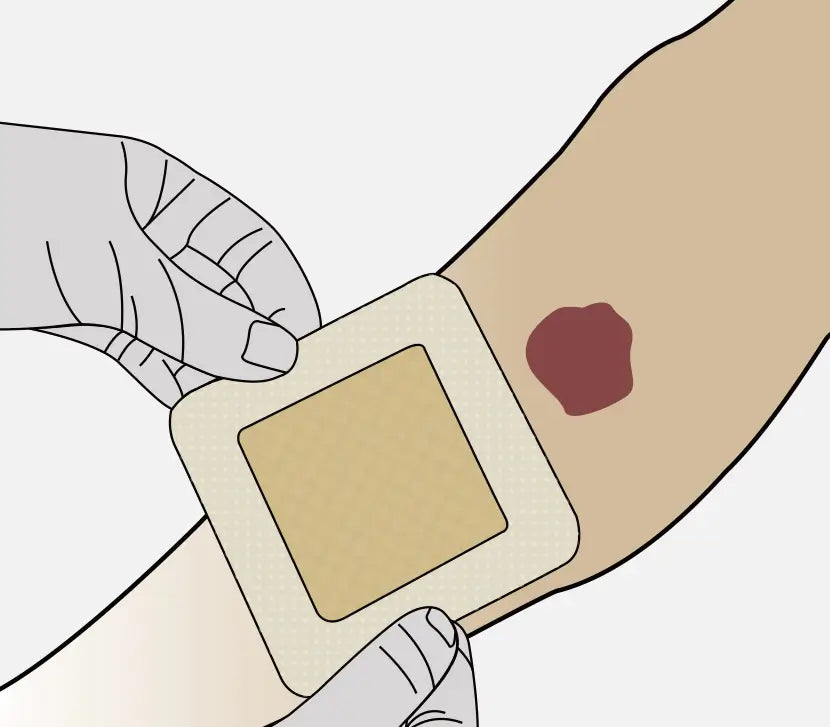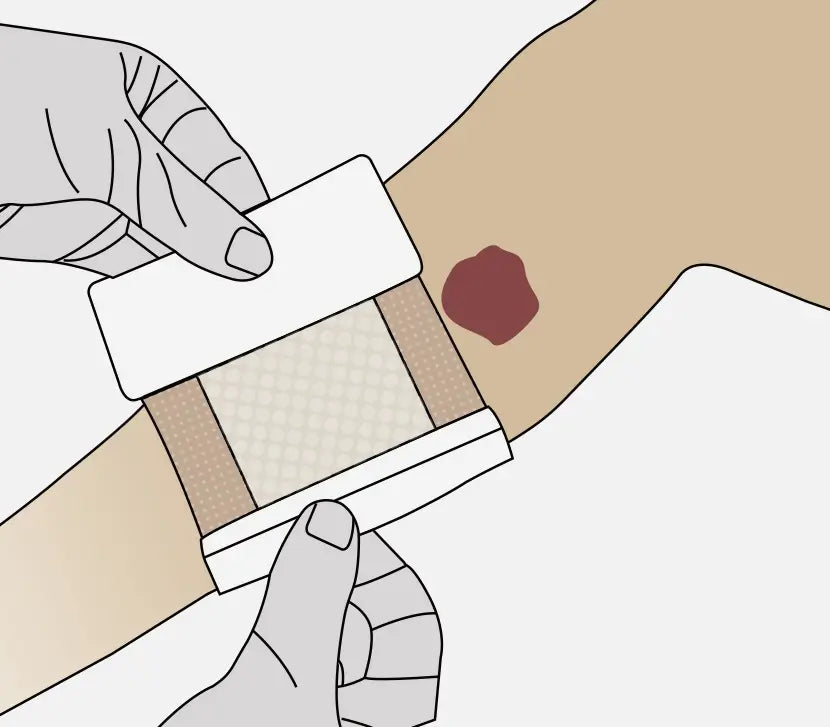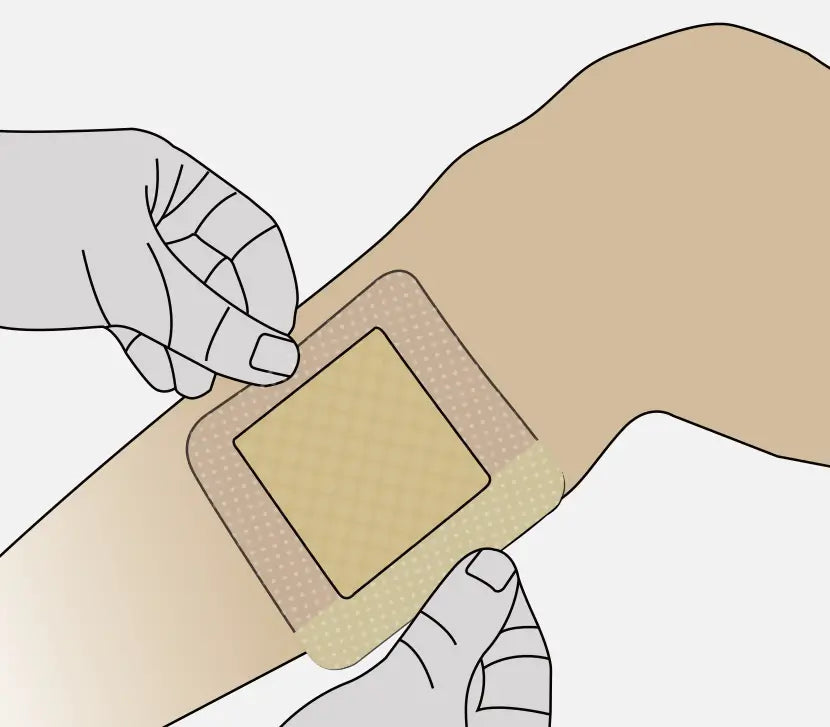
Skin Tear Dressing for Wound Healing – Gentle, Safe & Effective Care
Indications
Applicable to variety of acute and chronic wounds, especially highly exudating wounds.
Can be used in the prevention and treatment of various pressure ulcers.
DETAILS
Material
- Waterproof PU film layer
- Super absorbent fiber layer
- Unidirectional flow-through layer
- Foam absorbent layer
- Silicone wound layer
Main Mechanisms
- Moist Healing: Silicone gel foam dressings create a moist wound environment, which helps accelerate cell regeneration, promote wound healing, and reduce scar formation. This environment keeps the wound moist, prevents cracking, and enhances the healing process.
- Absorptive Property: Silicone gel foam dressings effectively absorb wound exudate, helping to reduce edema around the wound and keeping the wound clean and dry to prevent infection. The foam structure can hold a large amount of exudate, maintaining even moisture levels on the wound surface.
- Protective Function: The dressing forms a protective barrier over the wound, shielding it from external contamination and irritants. This reduces mechanical friction on the wound, prevents further damage, and protects the wound from infection and bacterial invasion.
- Pain Reduction: The soft and comfortable nature of the dressing alleviates pain caused by contact between the wound and the external environment. It is particularly effective during dressing changes, minimizing sensitivity to stimulation.
- Promoting Self-repair: The silicone gel forms a thin film over the wound surface, enhancing the skin's barrier function, facilitating self-repair, and reducing the risk of secondary infection.
- High Adaptability: Silicone gel foam dressings are highly versatile and suitable for various types of wounds, including superficial wounds, deep wounds, and exudative wounds. Dressing changes are typically easier and less likely to cause secondary irritation to the wound.
Key Feature
- Waterproof and breathable
- Prevents the formation of wound scars
- Easy to apply, does not stick to hair
- High absorption capacity, can maintain appropriate temperature and humidity of the wound, conforms to the principle of "wet healing", and promotes wound healing
- Can be repeatedly applied so that the wound condition can be checked at any time
- Painless removal without adhesion to the wound
- Soft and comfortable, acts as a "cushion"
Cautions
- Coverage should be 2cm/1in beyond the edge of the wound.
- Not for use with oxidizing solutions, such as Hypochlorite solution or Hydrogen peroide solution.
- Discontinue use if the patient is allergic to silicone.
- Not suitable for infected wounds.
- Not suitable for sinus wounds.

Guide to Silicone Foam Dressings for Effective Wound Healing
Silicone foam dressings are gentle, non-adherent wound coverings specially designed to protect fragile skin from further injury. Perfect for skin tears, pressure ulcers, and surgical wounds, these dressings create a protective barrier while maintaining an optimal moist healing environment.
CEEPORT’s silicone foam dressing ensures pain-free removal, excellent breathability, and comfort for sensitive skin, making it an ideal choice for elderly and high-risk patients seeking effective wound care.

Why CEEPORT’s Silicone Dressing Excels in Skin Tear Healing
CEEPORT’s silicone foam dressing is specially designed to provide gentle yet effective protection for fragile and delicate skin. Ideal for skin tears, pressure ulcers, and post-surgical wounds, it creates a protective barrier that maintains a moist healing environment, promoting faster recovery while preventing further injury.
Key reasons it excels:
- The soft silicone layer adheres to surrounding skin, not the wound, minimizing trauma during dressing changes.
- Allows air circulation while keeping the wound protected and comfortable for long-term wear.
- The foam core effectively absorbs exudate, reduces leakage, and lowers infection risk.
- Perfect for elderly, diabetic, or sensitive skin, ensuring effective care without compromising skin integrity.
With its innovative design and patient-centered comfort, CEEPORT’s silicone dressing is the top choice for skin tear management, combining safety, efficiency, and gentle wound care in one solution.

When Not to Use
- Third-degree burns
- Infected wounds requiring debridement
- Heavy bleeding wounds
Helpful Tips for Skin Tear Prevention
Preventing skin tears is essential, especially for elderly individuals, patients with fragile skin, or those with chronic conditions. Here are some practical tips to reduce the risk:
- Moisturize daily to maintain skin elasticity and strength.
- Avoid pulling or stretching the skin during dressing changes or bathing.
- Use protective padding or silicone foam dressings on high-risk areas like elbows, arms, and legs.
- Remove sharp edges, clutter, and obstacles that may cause accidental bumps or scrapes.
- Soft, loose-fitting clothing reduces friction and prevents trauma.
- Monitor skin integrity, especially for those with diabetes or circulatory issues.
Using CEEPORT’s silicone foam dressing alongside these prevention strategies provides an extra layer of protection, reduces the risk of skin tears, and supports safe, effective wound care for sensitive skin.
Easy to Use

Clean
Clean the assess the wound as appropriate to ensure that the skin around the wound is dry.

Choose
Choose a dressing that is at least an inch larger than the wound.

Apply
Remove one side of the film liner and place the dressing on the wound and surrounding skin.

Press
Remove the remaining film liner and press gently without tension to smooth the dressing.
You asked,we answered.
What types of wounds is it suitable for?
- Pressure ulcers (bedsores)
- Surgical wounds
- Traumatic wounds (cuts, abrasions)
- second-degree burns
- Diabetic foot ulcers
- Skin tears or fragile skin
Why choose silicone over traditional adhesives?
Silicone adhesives are gentler on the skin, especially for elderly patients or those with fragile or sensitive skin. They reduce the risk of skin stripping and pain during removal.
How much fluid can it absorb?
Foam dressings with border are designed to absorb moderate to heavy exudate, keeping the wound environment moist while protecting the surrounding skin from maceration.
Is the dressing waterproof?
Our silicone foam bandagess have a semi-permeable waterproof backing, allowing moisture vapor to escape while blocking water and bacteria from entering.
How often should I change the dressing?
Silicone foam border dressing changes typically occur every 3–5 days, or sooner if the dressing becomes saturated or loses adhesion. The frequency may vary depending on wound condition and exudate level.
Does it hurt to remove?
No. One of the main benefits of bordered foam dressings is painless removal. The silicone layer adheres gently to the skin without sticking to the wound bed.




